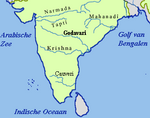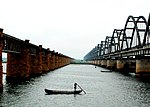Hyderabad–Godavari Valley Railways
 Railways in Hyderabad 1909 | |
| Overview | |
|---|---|
| Headquarters | Secunderabad Station |
| Locale | Hyderabad State and Madras Presidency (present Telangana and Maharashtra) |
| Dates of operation | October 1900–(1950 nationalized by government of India under Indian Railways) |
| Predecessor | Newly Built line |
| Successor | Central Railway(1951), South Central Railway(1966) |
| Technical | |
| Track gauge | MG |
| Length | 391 miles |
The Hyderabad–Godavari Valley Railway was established by the Nizam of Hyderabad as a part of The Nizam's Guaranteed State Railway a company under the guarantee of the Hyderabad State. The railway was part of the 467 miles (752 km) of broad gauge and 391 miles (629 km) of the narrow gauge(meter gauge) opened in the state between 1899 and 1901.
History
John Wallace Pringle was appointed as the superintending engineer for the survey and construction of the Hyderabad–Godavari Valley Railway in 1896.[1] The metre gauge railway runs for 391 miles (629 km) from Hyderabad city to Manmad on the north-eastern section of the Great Indian Peninsula Railway and was opened in October 1900. The Nizam's Guaranteed State Railway owned by a company under the guarantee of the Hyderabad State, capital for which was raised by the issue of redeemable mortgage debentures.
The total capital expenditure of the Nizam's State Railway at the end of 1904 was 4.3 crores. The Hyderabad–Godavari Valley Railway had cost 2.6 crores, and earned 7.7 lakhs net in the same year, which is nearly 3 per cent, but in 1901 and 1902 the earnings have increased to about 3½ per cent.
Districts covered
Atraf-i-Balda District
The Nizam's State Railway crosses the state from east to west, with six stations, and the Hyderabad–Godavari Valley line starting from Hyderabad (Atraf-i-Baldah) had one station within its limits. The total length of railways was about 98 miles (158 km).
Medak District
The Nizam's Guaranteed State Railway enters Medak from the west at Gullaguda and passes out at Lingampalli in the east, a distance of 22 miles (35 km). The Hyderabad–Godavari Valley Railway runs almost due north and south through Manoharabad, Masaipet, and Mirzapalli on the eastern border of the District
Nizambad District
The Hyderabad–Godavari Valley Railway traverses the Railways. District from the north-west to the south for 80 miles (130 km), with ten railway stations within its limits.
Nanded District
The Hyderabad–Godavari Valley Railway traverses the District from east to west for 40 miles (64 km), with six stations.
Parbhani District
The Hyderabad–Godavari Valley Railway traverses the District from east to west for a distance of 63 miles (101 km), and has 9 stations within its limits.
Aurangabad District
The Hyderabad–Godavari Valley Railway traverses Aurangabad from west to east, for 96 miles (154 km), with eleven railway stations within the District.
The cotton industry and the railways
In the early twentieth century, cotton being the largest export of Hyderabad State, the cotton industry held an important place in the eyes of Nizam's Hyderabad Government.
In 1889 a cotton spinning and weaving mill was erected in Aurangabad city, which employed 700 people. With the opening of the Hyderabad–Godavari Valley Railways in the year 1900 several ginning factories were started. In the Jalna alone there were 9 cotton ginning factories and five cotton presses, besides two ginning factories at Aurangabad and Kannad, and one oil press at Aurangabad. The total number of people employed in the cotton presses and ginning factories in the year 1901 was 1,016.
The area of cultivated land under cotton in 1914 was three million acres (12,000 km²), and most of the cotton was grown in the Marathwara districts, where the soil was peculiarly well suited to it. The opening of the Hyderabad–Godavari Railway, in October 1900, gave a great impetus to the growth of cotton in the Nizamabad, Nander, Parbhani and Aurangabad Districts, where many ginning and pressing factories came into existence as soon as heavy machinery could be brought there by rail. Bombay buyers then began to arrive in considerable numbers during the cotton season, which lasted from October to December, and as they paid cash for the cotton and would even send coolies to cut it and bring it to the cotton marts, more and more land began to be put down in cotton by the farmers. Hand gins gave place to ginning machines, and the farmers ceased to weed their fields carefully, and to cultivate only the best cotton. Grain and pulses then became more expensive, so much of the best land being laid down in cotton, and Marathwara entered upon a critical period of its existence.
Says the census report of the period: " The evolution from the agricultural to the manufacturing stage has already begun in Marathwara When a country begins to produce the raw materials of manufacture in place of food crops, it has started on the road to industrialisation."
There were three large spinning and weaving mills and about 90 small ginning and pressing factories in the State. The population supported by cotton spinning, sizing, and weaving in 1914 was 69,943 persons and by cotton ginning, cleaning, and pressing was 517,750 persons. The wages paid to the employees in these places were good, but the cost of living in Marathwara was very high, owing to the many holdings that are put down in cotton, and the uncertainty of the rainfall and availability of credit form money lenders.
References
- ^ "Inspecting Officers (Railways) – Pringle, (Sir) John Wallace". SteamIndex. Retrieved 10 July 2011.
This article includes a list of general references, but it lacks sufficient corresponding inline citations. (September 2009) |
Sources
- IRFCA
- "Hyderabad" by Mirza Mehdy Khan, Imperial Gazetteer of India, Government Printing Press, Calcutta, 1909.
- MODERN HYDERABAD (DECCAN) BY JOHN LAW CALCUTTA THACKER, SPINK & CO 1914.
- Articles needing cleanup from September 2009
- Cleanup tagged articles without a reason field from September 2009
- Wikipedia pages needing cleanup from September 2009
- South Central Railway Zone
- Secunderabad railway division
- Hyderabad State
- Transport in Aurangabad, Maharashtra
- History of rail transport in India
- Rail transport in Maharashtra
- Metre gauge railways in India
- Broad gauge railway lines in India






